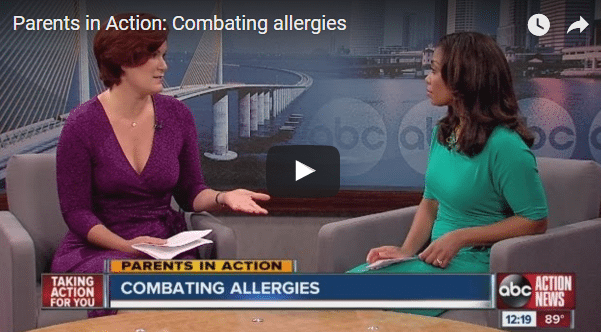COMBATING ALLERGIES

The air we breathe is full allergens like dust, pollen, mold spores and pollutants. Most children are unaffected by these intruders, but for those with asthma and allergies, simple contaminants can make life miserable.
Asthma and allergies are the result of exposure to allergens that create inflammation in the nose and lungs. Both conditions often start in childhood and continue throughout life. Although allergies can trigger asthma and asthma is often associated with allergies, they are actually two very different things.
Here’s some information to help you understand asthma and allergies, their triggers and some solutions to ease the endless runny nose.
What’s the difference between allergies and asthma?
Season allergies occur when airborne irritants kick your immune system into high gear, triggering a release of histamines, a chemical messenger that causes sneezing, runny nose, itchy throat and watery eyes. It’s important to note that even though we say allergies are seasonal, they typically occur year-round.
Asthma causes the airways in the lungs to become inflamed, making it hard to breathe. Symptoms of an asthma attack include coughing, shortness of breath, wheezing and tightness or pain in the chest. While many different substances and circumstances can trigger an asthma attack, for the majority of asthma sufferers the cause is linked to exposure to a host of allergens.
What is triggering my kids’ allergies?
Outdoor exposure to pollution, pollen and damp or cool weather is often blamed for allergy or asthma problems, but note that indoor exposure to irritants is more important. With kids spending more time indoors, many irritants may be in your house and you may not know it.
Smoke – Tobacco smoke can trigger an asthma attack and aggravate allergies. “Kids with asthma and allergies should never be exposed to tobacco smoke in their home, in a car or wherever they spend a lot of time,” Dr. Prpich of St. Joseph’s Children’s Hospital suggests.
Chemicals – Cologne and perfume can trigger a problem. The same is true for strong household cleaning products and scented candles. If it has a powerful odor, it might be a trigger.
Pets – While cats cause a higher degree of problems for asthma and allergy sufferers, dogs can be the source of the trigger too. Be sure to keep pets off furniture, out of the child’s bedroom and regularly bathe animals. You may also want to consider getting a hypoallergenic pet to avoid irritants.
What treatment options should look into?
For asthma, one of the most important treatments for asthma is to control the underlying inflammation of the airways. This can be done with medications or by avoiding environmental factors that cause or aggravate airway inflammation. Dr. Prpich suggests that parents work with their child’s doctor on a written asthma action plan. It should include information on the child’s symptoms, medications, rescue inhaler or nebulizer treatments, physical activity limits and instructions on what to do and whom to call if medication doesn’t help an attack.
For seasonal allergies, saline nose drops or a nasal wash can help remove mucus from the nose or flush pollen or other irritants out of the nasal passages. Antihistamines work well for treating allergies in children, and are often recommended when symptoms occur less frequently and don’t last for long. Allergy shots or immunotherapy may be necessary if symptoms are severe and fail to respond to other treatments.
For both asthma and allergies, experts agree that the best treatment is to take steps to reduce your child’s exposure to well-known irritants.
For a list of ways to protect your kids from allergens at home, visit TampaBayParenting.com/article/combating-asthma.